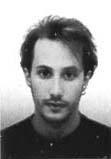Stockinger, Michael | Austria

Michael Stockinger (Mag.phil.) was born in 1973, studied English and French Literature and Linguistics at the KF University Graz and is currently working on his research project "Technology and the Text - The Interplay of Information Technology and Contemporary Narrative" (with Alen Vitas).
His article "Experiments on Living Matter or How to Save the Narrative from Extinction - The Unfinished Story of Jean Baudrillard's and Don DeLillo's Cultural Pathology" (based on his thesis) was published in: Elisabeth Kraus and Carolin Auer, eds., Simulacrum America: The USA and the Popular Media. Rochester, NY: Camden House, 2000. He is an actor and writer at the Theater im Bahnhof, Graz.
From April 2000 to December 2000 he was a Fellow at the Institute for Advanced Studies on Science, Technology and Society, Graz.
Project at IAS-STS: Technology and the Text: The Interplay of Information Technology and Contemporary Narrative
The central concern of the research project is to examine how contemporary information processing technology affects the established practices of storytelling in different media - how, in other words, technology has affected narrative structure in literature and cinema, and how it has lead to the development of new narrative forms such as hyperfiction and hypermedia. At the same time, the project investigates the cultural implications of these narratives - how these narratives influence the cultural perception of technology, and how they contribute to the construction of technology as a cultural master narrative.
The first part of the project is devoted to the analysis of cyberpunk SF - a recent (though shortlived) genre that is often seen as immediately inspired by information technology, and as almost exclusively devoted to problematizing its effects on society. The main interest of the project, however, lies in investigating the specific discourse of cyberpunk fiction - its narrative structure - which is marked by an excessive information density and a high-velocity narrative pace, often resulting in an impression of information overload. Since a narrative thus attempts to emulate - through its structure - the very technology that it describes, this discourse of overload (which, in the meantime, has spread beyond the genre of cyberpunk SF) would appear to have powerful consequences on the reception of a literary text: on the one hand, it can be seen as a mimetic device, faithfully representing the information society (and its shortcomings); on the other, it faces the argument that it is yet another superficial spectacle of that society, resisting interpretation and impeding critical thought.
The second part of the project investigates a different form of technological influence on narrative structure: the nexus of interactivity and narrative which we encounter in hyperfiction and in the postmodern novel. Regarding the former, it was information technology which has given rise to interactive literature (and other interactive media), in which the reader is free to determine the course of action - the reader thus becomes an active participant in the construction of the work. However, long before hyperfiction, a number of experimental postmodern novels have given up on conventional narrative structure, redefining themselves as complex information systems allowing for multiple readings - thus, although paper-bound, they require of their readers to become active participants in the construction of meaning. This seems to suggest that the conventional notion of 'narrative' - a story told by an author to an audience - needs to be redefined in order to accomodate new forms of (technologically-enhanced) storytelling, where 'narrative' is often an interactive, collaborative process, and where 'text' - far from being limited to 'writing' - is increasingly understood as a multimedia event.
